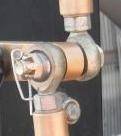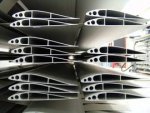Kolibri
FW and Gyros
- Joined
- Oct 17, 2014
- Messages
- 1,636
- Location
- Wyoming
- Aircraft
- Cessna 152, 172, 172RG, 177, 206 -- Piper 180 -- RV-7A -- Calidus -- RAF2000 -- Sport Copter II and
- Total Flight Time
- 1000+
Given that the RAF OEM hub bar and blades are so poorly designed and made, with such an abysmal service life,
I am very happy for my fellow RAF2000 owners that Gyro-Tech of Poland is offering a reasonably priced and apparently superior-to-RAF replacement.
Also, carbon-fiber rotor blades might be the best future option for gyros.
This is not unqualified praise for Gyro-Tech since I have several issues of design contention, and they haven't decades of gyroplane experience.
However, the RAF rotor system was so bad that it's not difficult to improve upon OEM, and it seems that G-T has so far done so (but not optimally, as I'll describe).
This was pointed out to you by a few folks here (me included) as well as by Trenna from Sport Copter.
However, you had installed Sport Copter rotors/bar in your old/worn RAF teeter towers, with unsurprisingly unsatisfactory results
(which you repeatedly misblamed on the SC blades themselves).
Are you still using your custom shimmy dampeners attached to the mast scissors?
Did Gyro-Tech include a polar chart from their PB-4 balancing?
The reason I ask is because a 350rrpm/30' diameter blade produces ~625Gs at the tip. 400rrpm produces ~750Gs.
teeter tower:
The rather deeply inletted factory name would seem to provide many possible stress risers. Such was a needless risk for brandname placement, IMO.
Exactly what spindle bolt bearings are in the teeter block, and how often must they be greased? What is their service life?
needle bearings in the Sport Copter teeter tower:
Since the SC design includes Zerk fittings for each tower, I've not found needle bearings to be any hassle.
hub bar:
You say that the blades have no service life, but what about the hub bar? It certainly hasn't an infinite life.
Regarding its design, I do not care for the very long tension strap bolts.
Even through its bushings, such bolts are more subject to bending loads.
Also, there is very little surface contact with the hub bar. (see photo below)
For those reasons, I think it preferable to mount the straps directly against the hub bar, as is common in the industry.
The larger surface area friction makes for a stronger assembly, while the bolts endure less bending force (if any).
Also, I really do not prefer G-T's reduction of section inward of the lateral pair of tension strap bolts.
The G-T hub bar radii should have been actual radii vs. milled flats (which can more easily collect stress risers).
bolts (tower block, tension straps):
Since the other G-T bolts are not AN-spec, I presume the spindle "Jesus" bolt also was not?
What is G-T's reason for not using cadmium-plated AN bolts/nuts?
Also, the four tower block bolts seem ~.125" short, as I've heard from multiple sources that many A&Ps and FAA inspectors
like to see at least 2-3 complete threads beyond the nut. (This would be a convenient time to replace them with proper AN hardware.)
____
While I'm relieved for my fellow RAFnauts that they've now a new affordable way to upgrade from RAF's sucky bar/blades, there still remain some remaining RAF issues:
the RAF OEM torque tube:
A very poor design, with little conception of aluminum's properties. The photo below is of a torque tube that broke upon impact (not in flight).
Notice the meager mass of material between the spindle bolt and pitch bolt hole. It's only about .5".
I've handled this very part, and although you can't see it from the photo, the crystalized interior is clear evidence that the metal has been worked.
There's simply too much dynamic stress going on inside that cubic 1" of aluminum.
Has one ever failed in flight? Not that we know of, but what service life can one rationally expect from the RAF torque tube?
As typical with most RAF parts, who can really say. Thus, if anyone is replacing their RAF bar/rotors, I think they'd be wise to also replace
their RAF torque tube (with, at the very minimum, a new OEM part).
If OEM cost/availability is any issue, I've a 370 hour used part which I could sell to someone wanting to replace their much higher time part. PM me if interested.
Quite frankly, fabricating a custom steel tube out of 4130 would be be a very simple matter, with lightening holes easily added.
The Sport Copter rotorhead/torque tube is a far superior design, and I considered its $3,000 price an "insurance policy" well spent.
the RAF OEM trim system:
This is the other very poorly designed system, which applies trim forces to the control system (i.e., the lower control yoke) rather than properly to the rotorhead directly.
I think the lower control yoke is rather dainty as it is (and RAF PN40 agrees), thus adding trim forces there was a mistake.
A parallel trim system outside the control system is wise, and my Sport Copter 4-way air-trim provides a "secondary" control system which could save my life.
____
In summary, the Gyro-Tech teeter towers/hub bar/rotor package seems a qualitative upgrade from RAF OEM parts, and I'm glad that it's flying well for eddie,
but don't become complacent about the other flight critical junk still in the RAF.
Also, until this G-T package has been flown for many hundreds of hours on the RAF, the old adage applies: "a new broom sweeps clean".
Regards, Kolibri
I am very happy for my fellow RAF2000 owners that Gyro-Tech of Poland is offering a reasonably priced and apparently superior-to-RAF replacement.
Also, carbon-fiber rotor blades might be the best future option for gyros.
This is not unqualified praise for Gyro-Tech since I have several issues of design contention, and they haven't decades of gyroplane experience.
However, the RAF rotor system was so bad that it's not difficult to improve upon OEM, and it seems that G-T has so far done so (but not optimally, as I'll describe).
Yes, and such was the natural benefit of buying new rotors/bar with their factory teeter towers.The factory balancing paid off because I will not have to make any adjustments at all, the blades are smooth
and I noticed instantly that the cabin shake and rudder pedal vibrations were completely gone.
This was pointed out to you by a few folks here (me included) as well as by Trenna from Sport Copter.
However, you had installed Sport Copter rotors/bar in your old/worn RAF teeter towers, with unsurprisingly unsatisfactory results
(which you repeatedly misblamed on the SC blades themselves).
Are you still using your custom shimmy dampeners attached to the mast scissors?
Did Gyro-Tech include a polar chart from their PB-4 balancing?
So, G-T is now making blades longer than specified limitations on their website? Which airfoil are yours?The blades and hubbar are the exact length as the RAF parts so the 30' diameter is maintained.
How are those metal tip weights attached, and what is their weight? What is the tensile strength of the fastener?The only metal is the bushings installed for the mounting bolts and the tip weights.
The reason I ask is because a 350rrpm/30' diameter blade produces ~625Gs at the tip. 400rrpm produces ~750Gs.
teeter tower:
The rather deeply inletted factory name would seem to provide many possible stress risers. Such was a needless risk for brandname placement, IMO.
Exactly what spindle bolt bearings are in the teeter block, and how often must they be greased? What is their service life?
needle bearings in the Sport Copter teeter tower:
Since the SC design includes Zerk fittings for each tower, I've not found needle bearings to be any hassle.
hub bar:
You say that the blades have no service life, but what about the hub bar? It certainly hasn't an infinite life.
Regarding its design, I do not care for the very long tension strap bolts.
Even through its bushings, such bolts are more subject to bending loads.
Also, there is very little surface contact with the hub bar. (see photo below)
For those reasons, I think it preferable to mount the straps directly against the hub bar, as is common in the industry.
The larger surface area friction makes for a stronger assembly, while the bolts endure less bending force (if any).
Also, I really do not prefer G-T's reduction of section inward of the lateral pair of tension strap bolts.
The G-T hub bar radii should have been actual radii vs. milled flats (which can more easily collect stress risers).
bolts (tower block, tension straps):
the flight testing has been delayed because the 1/2" bolt that hold the rotor head on was to short,a new AN bolt from ac spruce will be here today.
Since the other G-T bolts are not AN-spec, I presume the spindle "Jesus" bolt also was not?
What is G-T's reason for not using cadmium-plated AN bolts/nuts?
Also, the four tower block bolts seem ~.125" short, as I've heard from multiple sources that many A&Ps and FAA inspectors
like to see at least 2-3 complete threads beyond the nut. (This would be a convenient time to replace them with proper AN hardware.)
____
While I'm relieved for my fellow RAFnauts that they've now a new affordable way to upgrade from RAF's sucky bar/blades, there still remain some remaining RAF issues:
the RAF OEM torque tube:
A very poor design, with little conception of aluminum's properties. The photo below is of a torque tube that broke upon impact (not in flight).
Notice the meager mass of material between the spindle bolt and pitch bolt hole. It's only about .5".
I've handled this very part, and although you can't see it from the photo, the crystalized interior is clear evidence that the metal has been worked.
There's simply too much dynamic stress going on inside that cubic 1" of aluminum.
Has one ever failed in flight? Not that we know of, but what service life can one rationally expect from the RAF torque tube?
As typical with most RAF parts, who can really say. Thus, if anyone is replacing their RAF bar/rotors, I think they'd be wise to also replace
their RAF torque tube (with, at the very minimum, a new OEM part).
If OEM cost/availability is any issue, I've a 370 hour used part which I could sell to someone wanting to replace their much higher time part. PM me if interested.
Quite frankly, fabricating a custom steel tube out of 4130 would be be a very simple matter, with lightening holes easily added.
The Sport Copter rotorhead/torque tube is a far superior design, and I considered its $3,000 price an "insurance policy" well spent.
the RAF OEM trim system:
This is the other very poorly designed system, which applies trim forces to the control system (i.e., the lower control yoke) rather than properly to the rotorhead directly.
I think the lower control yoke is rather dainty as it is (and RAF PN40 agrees), thus adding trim forces there was a mistake.
A parallel trim system outside the control system is wise, and my Sport Copter 4-way air-trim provides a "secondary" control system which could save my life.
____
In summary, the Gyro-Tech teeter towers/hub bar/rotor package seems a qualitative upgrade from RAF OEM parts, and I'm glad that it's flying well for eddie,
but don't become complacent about the other flight critical junk still in the RAF.
Also, until this G-T package has been flown for many hundreds of hours on the RAF, the old adage applies: "a new broom sweeps clean".
Regards, Kolibri
Attachments
Last edited:






